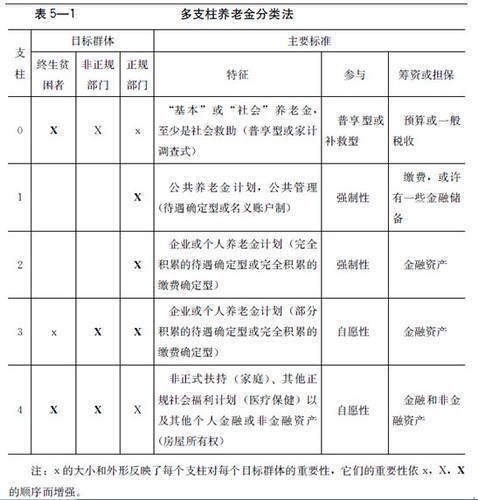圖:蘋果日報
政府在二零一三年五月二十一日向立法會福利事務委員會提交 CB(2)1129/12-13(07)號文件,表示:『香港現行的退休保障制度包括三根支柱, 分別為無須供款的社會保障制度(由綜合社會保障援助(綜援)計劃,以及高齡津貼、長者生活津貼和傷殘津貼計劃組成)、自2000年起實施的強制性公積金(強積金)制度、以及個人自願儲蓄組成。這模式與世界銀行倡議的多根支柱模式相符。』
『就此,扶貧委員會的社會保障和退休保障專責小組在 3月18 日的第二次會議上同意邀請周永新教授就退休保障進行研究,提出其他完善長者社會保障和退休保障的可行方案。』
勞工及福利局在二零一四年二月表示:『研究團隊預計可在二零一四年年中前向扶貧委員會轄下社會保障和退休保障專責小組提交最終報告供委員檢閱。政府會以開放及務實的態度,考慮退休保障的未來路向。』
何謂世界銀行倡議的多根支柱模式
Old-Age Income Support in the 21st Century
An International Perspective on Pension Systems and ReformThe suggested multipillar pension system is composed of some combination of five basic elements: (a) a noncontributory or “zero pillar” (in the form of a demogrant or social pension) that provides a minimal level of protection; (b) a “first-pillar” contributory system that is linked to varying degrees to earnings and seeks to replace some portion of income; (c) a mandatory “second pillar” that is essentially an individual savings account; (d) voluntary “third-pillar” arrangements that can take many forms (individual, employer sponsored, defined benefit, defined contribution) but are essentially flexible and discretionary in nature; and (e) informal intrafamily or intergenerational sources of both financial and nonfinancial support to the elderly, including access to health care and housing.
Page 42
「零支柱」是市民無需供款的基本退休金計劃,由政府出資,為長者提供最低程度的養老保障,防止長者落入赤貧狀態,但通常設有經濟審查機制;
「第一支柱」是與收入掛鈎的強制性公共退休金計劃,政府對合資格的長者給予退休金;
「第二支柱」是與收入掛鈎的強制性職業或私人退休金計劃,要求僱員或僱主或雙方在退休前為職業退休計劃進行供款,確保收入較高的市民除了基本的公共退休保障金之外,還能獲得額外退休金;
「第三支柱」是向職業或私人退休金作自願性供款計劃,以個人儲蓄協助維持長者退休後的生活水平;
「第四支柱」是非財政的支援,包括非正規支援(例如家庭支援)、其他正規社會保障計劃(例如醫療護理),以及其他個別金融和非金融資產,協助提升長者退休後的生活水平。
是否相符
我們認為香港目前的三支柱模式,並不符合世界銀行2005年所發表了《21世紀老年入息的支援——退休金制度及改革的國際視野》報告書倡議的多根支柱模式。
Adequate refers to both the absolute level (preventing old-age poverty) as well as the relative level (replacing sufficient lifetime earnings) of retirement income that the pension system will provide. The goal of any pension reform should be to ensure that all people regardless of their level or form of economic activity have access to the capacity to remain out of extreme poverty in old age and that the system as a whole provides assurances that those individuals who live beyond the expected norms will be protected from the “risk” of extreme longevity.
Page 55
世銀報告在第三章中解釋,其觀點的目標有首要目標和次要目標,首要目標包括:養老制度的充足性、可負擔性、可持續性和穩定性;其中的充足性要求在絕對水平上防止老年貧窮,對象應該是所有人。

table 5.1. Multipillar Pension Taxonomy Page 82
第82頁的表列5顯示:終身貧窮者依靠支柱零和支柱四;非正規部門(即家庭主婦,長散工等)依靠支柱零、三和四。嚴格來說,香港的三支柱制度不是全民性。香港的綜援制度不符合世銀的支柱零的標準。
香港最新制定的貧窮線以相對貧窮作量度原則。它以入息中位數的一半訂立一條貧窮主線。此入息中位數指政策介入前的家庭收入(即不包括綜合社會保障援助、高齡津貼等政策介入現金福利)。其有別於政府統計處在綜合住戶統計調查發表的數據。
定出貧窮界線,就是要找出最需要幫助的人。美國以購買「基本食品」價格開支的三倍作三人家庭的貧窮門檻。迴避了絕對貧窮的概念,即是迴避了人民的基本生活需要的理念。
因此,周永新有責任指出香港的現行退休保障制度,並不符合世界銀行的要求。


